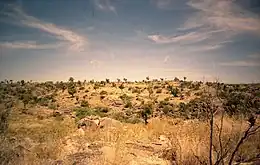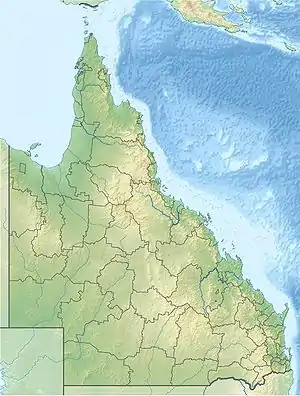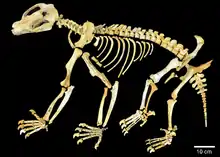Riversleigh World Heritage Area
Riversleigh World Heritage Area is Australia's most famous fossil location, recognised for the series of well preserved fossils deposited from the Late Oligocene to more recent geological periods. The fossiliferous limestone system is located near the Gregory River in the north-west of Queensland, an environment that was once a very wet rainforest that became more arid as the Gondwanan land masses separated and the Australian continent moved north. The approximately 100 square kilometres (39 sq mi) area has fossil remains of ancient mammals, birds, and reptiles of the Oligocene and Miocene ages, many of which were discovered and are only known from the Riversleigh area; the species that have occurred there are known as the Riversleigh fauna.[1]
| UNESCO World Heritage Site | |
|---|---|
 | |
| Location | Gregory, Queensland, Australia |
| Part of | Australian Fossil Mammal Sites (Riversleigh / Naracoorte) |
| Criteria | Natural: (viii), (ix) |
| Reference | 698-001 |
| Inscription | 1994 (18th Session) |
| Area | 10,029 ha (38.72 sq mi) |
| Coordinates | 19°2′S 138°38′E |
 Location of Riversleigh World Heritage Area in Queensland  Riversleigh World Heritage Area (Australia) | |
The fossils at Riversleigh are unusual because they are found in soft freshwater limestone which has not been compacted.[2] This means the animal remains retain their three-dimensional structure, rather than being partially crushed like in most fossil sites. The area is located within the catchment of the Gregory River.[3] Many of the fossil sites were crevices and limestone caves created by the action of large amounts of water on the karst formation, creating pitfall traps and feeding spots for predators which periodically and perhaps suddenly became covered and preserved; these conditions are responsible for the large assemblages of fossilised bats whose guano helped to conserve the remains of themselves and others.
Fossils were first noted to exist in the area in 1901.[4] An initial exploration survey was conducted in 1963. Since 1976, the area has been the subject of systemic exploration.[4] The site was co-listed with the Naracoorte Caves National Park in South Australia as a World Heritage Site in 1994, and by itself, it is an extension of the Boodjamulla National Park.[5]
Description

Fossils at Riversleigh are found in limestone by lime-rich freshwater pools, and in caves, when the ecosystem was evolving from rich rainforest to semiarid grassland community. Some of the fossils at Riversleigh are 25 million years old.[6] High concentrations of calcium carbonate have meant the fossils are extremely well preserved.[6] The fossil collection reveals mammalian evolution across more than 20 million years.[3] Fossils have been found in more than 200 individual locations.[4] The fossil record here is significant because it provides evidence on evolution and the distribution of species across Gondwana.
The presence of Riversleigh fauna in the Oligo-Miocene has been classified by four "faunal zones", and used to denote the presence of fossil taxa in these time periods.[7] These may be summarised as
- Faunal Zone A (FZA): Late or Upper Oligocene, 28.4 to 23.03 million years ago
- Faunal Zone B (FZB): Early or Lower Miocene, 23.03 to 15.97 Ma
- Faunal Zone C (FZC): Middle Miocene, 15.97 to 11.608 Ma
- Faunal Zone D (FZD): Late or Upper Miocene, 11.608 to 5.332 Ma
Thirty-five fossil bat species have been identified at the site, which is the richest in the world.[3] Cave deposits have been particularly rich in bat species.[4]
The skull and nearly complete dentition of a 15-million-year-old monotreme, Obdurodon dicksoni, provide a window into the evolution of this characteristically Australian group. Fossil ancestors of the recently extinct thylacine, Thylacinus cynocephalus, have also been identified among Riversleigh's fauna. In 1993, skulls of the koala-like Nimbadon were unearthed in a previously unknown cave in the region.[8] Researchers estimate that this marsupial first appeared about 15 million years ago and died out about 12 million years ago, perhaps from climate change-induced losses in habitat.[9] A well-preserved skull of the ancient Nimbacinus dicksoni, an extinct relative of the thylacine, has been used to determine the hunting behavior of the species.[10]
Other fossils have provided evidence of how the koala has evolved in response to Australia's change from predominant rainforest vegetation to drier eucalypt forests.[11] The fossil bird fauna at Riversleigh includes an artamid Kurrartapu johnnguyeni, a fossil sittella,[12] and representatives of various other families of modern birds.[13][14][15] Some fossil insects and plants have also been discovered.[4]
The fossil species identified at the sites are collectively known as the Riversleigh fauna.[16]
Research
Scientific studies are mostly conducted by a group of palaeontologists from the University of New South Wales.[6] Mike Archer is a paleontologist who has been working at Riversleigh since 1983. He and his co-workers discovered that diluted acetic acid was the most effective method of extracting fossils.[4] Karen Black, a palaeontologist from UNSW, discovered a new species of extinct koala, at Riversleigh, which was then named after Dick Smith.[17]
See also
References
- Archer M; Hand, Suzanne J. & Godthelp H. [1991] 2000. Australia's lost world: Riversleigh, World Heritage Site. Reed, Sydney.
- Anna Salleh (16 February 2006). "Huge skulls clues to snake evolution". ABC Science. Australian Broadcasting Corporation. Retrieved 5 August 2010.
- "Australian Fossil Mammal Site - Riversleigh more information". Department of Sustainability, Environment, Water, Population and Communities. 15 May 2008. Retrieved 28 July 2012.
- The Australian Heritage Council (2012). Australia' Fossil Heritage: A Catalogue of Important Australian Fossil Sites. Csiro Publishing. pp. 43–44. ISBN 978-0643102309. Retrieved 28 July 2012.
- "Australian Fossil Mammal Sites (Riversleigh / Naracoorte)". UNESCO World Heritage Centre. Retrieved 17 May 2015.
- "Riversleigh World Heritage Site, Boodjamulla (Lawn Hill) National Park: Nature, culture and history". Department of Environment and Resource Management. 14 December 2011. Archived from the original on 13 September 2011. Retrieved 28 July 2012.
- "Faunal zones". Faunal encyclopedia. wakaleo.net. Retrieved 28 May 2019.
- "Cave yields marsupial fossil haul". BBC News. 19 July 2010. Retrieved 5 August 2010.
- Fossils reveal prehistoric life cycle. Australian Geographic. 20 July 2010.
- Jonathan Marker (10 April 2014). "This meat-eating marsupial may have hunted prey larger than itself". Science Recorder News. Archived from the original on 13 April 2014. Retrieved 11 April 2014.
- Dan Gaffney (19 December 2009). "Loud and lazy but didn't chew gum: Ancient koalas". PhysOrg. PhysOrg.com. Retrieved 5 August 2010.
- Nguyen, JMT (2016). "Australo-Papuan treecreepers (Passeriformes: Climacteridae) and a new species of sittella (Neosittidae: Daphoenositta) from the Miocene of Australia". Palaeontologia Electronica. 19.1.1A: 1–13. doi:10.26879/602.
- Boles, WE (1998). "A budgerigar Melopsittacus undulatus from the Pliocene of Riversleigh, North-western Queensland". Emu. 98 (1): 32–35. doi:10.1071/MU98004.
- Boles, WE (2005). "A review of the Australian fossil storks of the genus Ciconia (Aves: Ciconiidae), with the description of a new species". Records of the Australian Museum. 57 (2): 165–178. doi:10.3853/j.0067-1975.57.2005.1440.
- Nguyen, JMT, Hand SJ, Archer M (2016). "The late Cenozoic passerine avifauna from Rackham's Roost Site, Riversleigh, Australia". Records of the Australian Museum. 68 (5): 201–230. doi:10.3853/j.2201-4349.68.2016.1668.
- "wakaleo.net — Riversleigh News and Faunal Encyclopedia".
- Queensl, The University of; Lucia, Australia Brisbane St; Gatton, QLD 4072 +61 7 3365 1111 Other Campuses: UQ; Maps, UQ Herston; Queensl, Directions © 2022 The University of. "20 million year old koala named after Dick Smith". UQ News. Retrieved 15 April 2022.
Further reading
- Archer, M. et al. 1991. Riversleigh: the Story of Australia's Inland Rainforests, (Sydney: Reed Books)